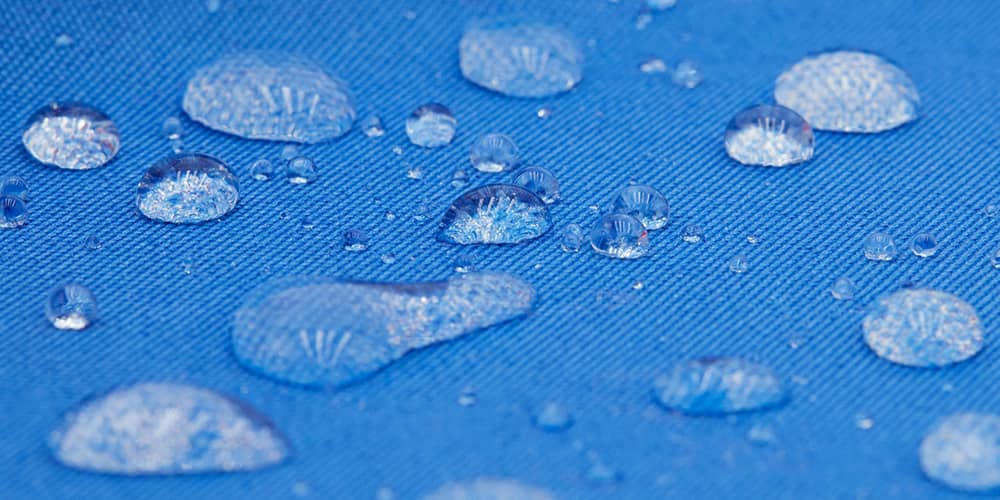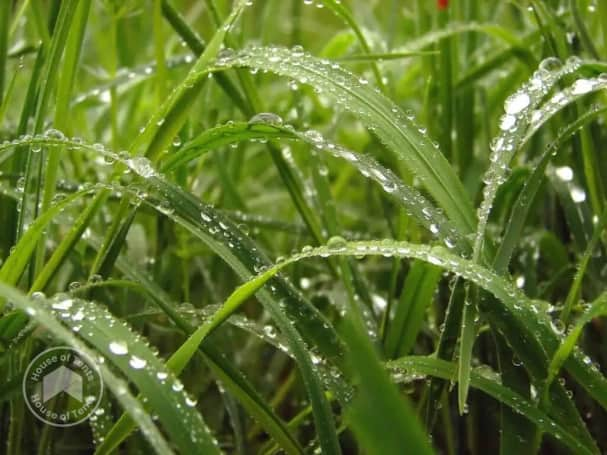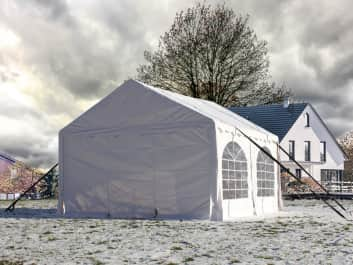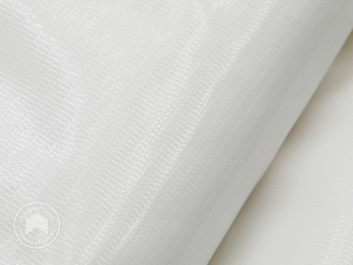
What causes condensation in tents & how to prevent it
Are you struggling with damp and even mould in your tent? Are you finding droplets of water forming on the tent poles? You may very well feel irritated because you were told that your tent was 100% waterproof. That’s understandable, but the source of your frustration hasn’t appeared from outside the tent, but rather it has likely condensed from the air inside the tent. We know that a lot of our customers struggle with condensation problems.
These contents await you in the article:
What is condensation and how does it occur?
The process of condensation can be seen in many situations. On cold clear nights we often wake up to find dew formed on grass. Many homeowners struggle with misty windows over the winter. You will also have observed the way that water droplets form on the outside of an ice-cold beverage on a summer’s day. You may also be battling damp in a tent, with moisture dripping from the tent walls.

Condensation occurs when water molecules within the air condense into a liquid on cold surfaces. This often happens when the surface is colder than the dew point. The dew point changes according to the level of humidity in the air. In humid conditions, the dew point will be higher, meaning that condensation is more likely to form. In the winter time condensation is also more likely to form, because the air is already close to the dew point.
If left unchecked, damp in the tent can affect the quality of perishable goods and even lead to the presence of mould. In most cases, mould can be cleaned away with warm soapy water. For more difficult stains, we recommend the use of an alkaline based PE / PVC cleaner.
For emergencies you may choose to use an industrial strength dehumidifier for drying the tent. The tent is not air tight, so using a dehumidifier is not a viable long-term option. A dehumidifier however, can help to dehumidify the tent in the short term and get mould under control. Read further for our top tips for reducing tent condensation over the long term.
The 4 key causes of condensation in marquees and tents
Air temperature
If there is a large difference in the temperature inside the tent to the outside, this can lead to condensation. Such fluctuations occur, for example, before and after rain or when it cools down quickly outside while it is still warm inside the tent.
Air humidity
If you have the tent set up in humid conditions, you are much more likely to experience damp problems in the tent. The most common source of humidity for many customers will be the guests inside the tent. Dancing and loud conversations are an integral part of great parties but there are side effects! Perspiration and breathing will contribute to the build up of damp in the tent. The damp air will then turn into condensation when it comes into contact with cold walls.
Ground conditions
Ground conditions play an important role. Even dry grounds can contribute to tent condensation. For instance, if your tent is pitched on grass, this will lead to more moisture in the air. That’s because grass gives off water vapour which is trapped in the tent.
Air flow
Without good airflow, warm air will settle on cold surfaces for long enough to cool down below the dew point and condense to a liquid. It’s therefore important that air can move freely and constantly around the tent.
Did you know?
At House of Tents we are well-prepared for the fight against dampness in tents. For example, the walls of our marquees are not hermetically sealed. Instead, they allow for the steady exchange of air from the outside. Thanks to these naturally breathable walls, good ventilation is guaranteed.
The frames of the tent halls are also perfectly equipped. If you choose an Everest industrial tent with a standard door, you will benefit from both removable gable sections, which give you particularly large entrances for ventilation, and an XXL floor skirt. This floor skirt runs around the entire tent frame and moves rainfall and other moisture away from the tent. The other big advantage of Everest industrial storage tents are the closable ventilation windows. Each gable section is equipped with a vent, which allows for a constant exchange of air between the outside and inside of the tent at all times. And the ventilation windows not only ensure a pleasant climate inside the storage tent, but make a long-term difference in reducing damp and condensation.
Does the material of the tent have an effect on condensation?
I bought a new tent, and now I've discovered leaks. It's dripping from the ceiling. Is the roof of my tent not waterproof? Is it due to the material of the tarpaulin or is it a manufacturer's fault?
Especially in the middle of winter, when its cold, raining, and temperatures can move from mild to freezing, it can happen that our tent experts receive messages like this one. All of our products are 100% waterproof, highly UV-resistant, stable and of the highest possible quality, from the material of the tarpaulin to the roof and the poles. This is what House of Tents stands for with its name and over 30 years of expertise.
But how can it still be that people have such negative experiences with their tents?

The answer of course is condensation. Just as with window panes or patio doors, condensation can form on tents. Here it makes no difference whether the tent product is 100% waterproof or not. Because tents are outdoors during the day, evening and night and experience all kinds of weather, the formation of condensation is a completely normal and natural phenomenon. So if it drips from the poles or moisture collects inside the tarp, this does not mean that your tent is leaking or of poor quality.
If you grew up with single glazed windows you will have plenty of experience with condensation. Many houses nowadays have double glazed windows that provide a buffer between the cold air outside and warm air inside, stopping condensation from forming. Unfortunately double glazing isn’t an option for tents! No matter what material you use for the tent, you won’t have the benefit of insulation to protect from falling outside air temperatures overnight. Once warm or humid air on the inside of the tent comes into contact with the roof tarpaulin the air will condense into water. The poles of the frame cool quickly and will draw moisture from the air.
For this reason it will be difficult to fully prevent condensation from forming. Given the right conditions, it will form even in the best quality tents. However, that’s not reason to dismantle your tent. You can reduce condensation dramatically with a number of simple steps.
Damp proofing: How can you prevent condensation from forming inside the tent?
Since the formation of condensation is a natural process, it cannot be completely avoided. However, it can be effectively reduced to a minimum. How exactly? We’ll tell you in our 6 top tips! *
Be aware of the main sources of damp and moisture
Dampness can come from many sources. Before you can proceed with damp treatment, you need to understand the causes. Here are some of the main culprits that create excess moisture in tents.
- Grass releases moisture over time, which will trapped under the canopy of the tent without adequate ventilation. Laying down a groundsheet is a good idea when pitching the tent on lush grass over longer periods.
- When a large number of people get together in a tent to celebrate a birthday, anniversary or marriage they leave behind a lot of water vapour in the air. This comes when people exhale, or perspire. Of course, you can’t ask your guests to breath less and you certainly don’t want to ask them to stay heated to avoid perspiration. A better approach is to air the marquee out thoroughly after parties.
- Avoid leaving wet items in the tent for long periods. If you are using a marquee as a changing room by the swimming pool, you should ensure that damp or wet towels and swimming gear aren’t left to dry inside the tent.
- Cooking food and warming drinks can release a lot of damp into the air. At home an extractor fan in the kitchen is effective at dealing with this problem. However in a tent you probably won’t have the luxury of an extractor fan to expel moist air. You may decide instead to partially open side walls next to cooking areas, or at hot drink stations to deal with this excess vapour.
A hygrometer measures the levels of humidity in the air and can give you a more accurate measure of the level of damp and humidity in the tent.
Ventilate the tent sufficiently
Probably the most important step in keeping condensation to a minimum and protecting your tent from potential mould growth is ventilation. Ventilate regularly and sufficiently. Leave the entrance open or remove side wall panels for a while whenever possible. This could be while you’re setting up the tent, cleaning after a party, or unloading and loading stock to a storage tent.
React appropriately to the climate
In addition to regular ventilation, we also recommend that you adjust the ventilation to the current climate. For example, if humidity levels are very high throughout the day, we would advise you to keep the side walls and entrances of your model closed during the day. Only in the evening and at night, when it cools down again, can you allow fresh air to enter again. Evening air generally contains less moisture, so you avoid the formation of water vapour.
Tension the canopy correctly
If you have a tent model with a tarpaulin for the roof, we recommend that you check it again carefully before the cold season sets in. There should be no folds in the roof tarpaulin, nor should the tension be too low. The more securely the tarpaulin is attached to the frame, the easier it is for air to circulate along the surface of the tarpaulin and the more robustly it will protect your tent from strong winds.
Use garden fleece
We recommend that you purchase garden fleece fabric. You can cut sheets of garden fleece to fit exactly and it is not only suitable as an environmentally friendly weed remover, but also to prevent or reduce condensation. The mesh sheets are easy and practical to install as wall insulation between the tarpaulin and the frame. Garden fleece absorbs the moisture contained inside your tent and the mesh fabric allows moisture to dry off again quickly when ventilated. It’s an extremely practical and cost-effective fabric that can be bought in any DIY or garden centre.
Don't overfill storage tents
It’s important that storage tents have room for air to circulate freely around the entire tent. Goods should be stored on pallets to ensure that there is airflow at ground level as well.
To wrap up
We’ve heard that general dampness and condensation problems are a common issue for our customers. We hope that this article can help you deal to interior condensation and makes for a drier tent.
What to remember: When air cools below the dew point, water droplets condense onto cold surfaces and condensation or general dampness forms. Damp walls, wet tent poles and even mould are typical results from air quality that is humid and damp. In summary, it’s useful to remember that the smaller the temperature difference between the interior of your tent and the outside temperature, the less condensation will occur.
Condensation is not due to poor quality tarpaulins or a manufacturer’s fault, but is caused by changeable weather conditions and damp problems that can be caused by a number of factors. It is important that you treat the problem quickly and dry the canopy to prevent the formation of mould. We also advise you to air the tent regularly and properly. If you’re having particular problems with excess moisture we recommend using a ground sheet or using garden fleece as insulation.
Do you have any questions on the subject or are you having difficulty with damp patches? Call us on +44(0)1183150873 or send an e-mail to [email protected] and we’ll be happy to answer your questions.
*Please note that this article is intended only as advice for owners of marquees, gazebos and storage tents. House of Tents accepts no liability or guarantee for potential damage to the tent.
Julia
Editor
Hey, I'm Julia and I'm very happy to be part of this colourful magazine. Whether it's tips on how to decorate your garden gazebo, informative articles on the many uses of professional tents or interviews, my aim is the same: to transport you into the world of tents and share my knowledge with you.
You may also be interested in:



